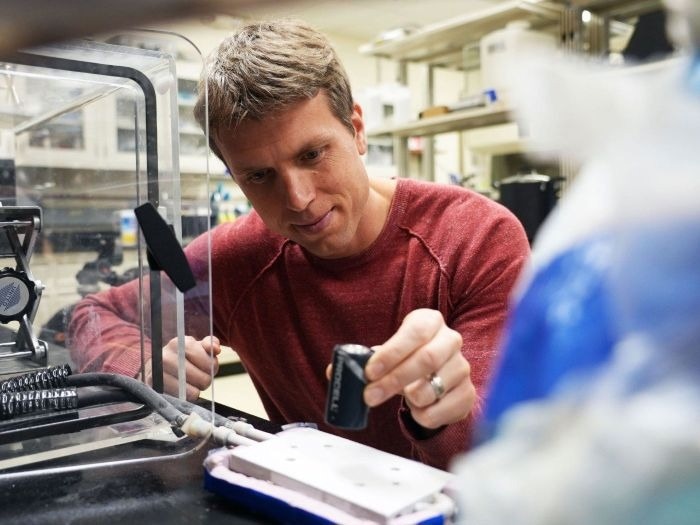By manipulating the electric charge within ice, researchers have developed a new technique to remove frost without heat or chemicals.

Ionic defects are present in every sheet of frost. Jonathan Boreyko’s team at Virginia Tech uses high voltage to polarize these ions and remove the ice in a new study in Small Methods.
During the winter, frost can cause havoc on planes, cars, heat pumps, and much more. But defrosting these thin sheets of ice using heaters is both slow and energy-intensive. Chemical defrosting, on the other hand, is costly and harmful to the environment.
Jonathan's team may have discovered a new and improved technique to deice, known as “electrostatic defrosting” (EDF).
By attacking ice by using its own physics rather than employing heat or chemicals, frost can be removed quickly, cheaply, and sustainably.
Previous research used the modest amount of voltage that naturally resides inside frost to polarize a nearby water film, resulting in an electric field capable of detaching minuscule ice crystals.
The research team is now expanding on this by providing a high voltage to an opposing electrode to remove frost from its surface more forcefully.
Charging Forward
Water molecules are arranged in a neat ice lattice in frost. However, occasionally a water molecule lands slightly off-pattern; it may have an additional hydrogen close by (H3O+) or is missing one entirely (OH–).
Imagine assembling a large jigsaw puzzle as quickly as possible. Every so often, a piece gets stuck, put in the wrong place, or disappears out of sight.
These tiny errors in frost result in ionic defects, which are areas of with slightly excessive positive or negative charge.
The team theorized that when a positive voltage was applied to an electrode plate held above the frost, the negative ionic defects would be attracted and “migrate” to the top of the frost sheet, while the positive ionic defects would be repelled and migrate to the frost's base.
This would mean the ice was highly polarized, with a strong attractive force to the electrode. If the attraction force is strong enough, ice crystals could fracture off and jump into the electrode.
The team found that the copper electrode eliminated 15 % of the frost, even in the absence of any applied voltage. This is due to the fact that frost can weakly self-polarize in the absence of an electric field.
Once voltage was applied at 120 V, 40 % of the frost disappeared. At 550 V, 50 % of the frost was removed.
We really thought we were onto something here. Keep turning up the voltage and more frost will jump away, right? What was unexpected was when the opposite happened.
Jonathan Boreyko, Associate Professor, Mechanical Engineering, Virginia Tech
As the power was increased above 550 V, something interesting happened: less frost jumped away, with only 30 % removal at 1,100 volts and 20 % at 5,500 volts. The results defied the team's hypothesis, which anticipated that performance would increase with increasing voltage.
When frost developed on an insulating glass substrate rather than a copper one, the higher voltages performed just marginally worse. This suggested that charge leakage from the polarized frost into the underlying substrate was occurring, particularly at high voltages, which could be reduced by adopting a more insulating surface.
After upgrading to an air-trapping superhydrophobic substrate, the greatest voltage eliminated the most ice, as predicted. Turning up the voltage now removes up to 75 % of the frost.
When using the superhydrophobic surface, the electrostatic defrosting was powerful enough to make a hidden Virginia Tech ‘VT’ logo become clearly visible on the surface after the frost jumped off.
Venkata Yashasvi Lolla, Study Lead Researcher, University of California, Berkeley
The study is ongoing, with the ultimate objective of finding a way to remove frost and ice completely. Part of this study will involve removing frost from other types of surfaces, broadening the potential uses for both industrial and consumer usage.
This concept of electric deicing is still in a very early stage. Beyond this first paper, our goal is to improve EDF by reducing charge leakage and attempt higher voltages and electrode placements, among various other emerging strategies. We hope that in the near future, EDF will prove to be a cost-effective, chemical-free, and low-energy approach to deicing.
Jonathan Boreyko, Associate Professor, Mechanical Engineering, Virginia Tech
Journal Reference:
Yashasvi Lolla, V. V., et al. (2025) Electrostatic Defrosting. Small Methods. DOI:10.1002/smtd.202501143.
Thumbnail Image Credit: SnapTPhotography/Shutterstock.com